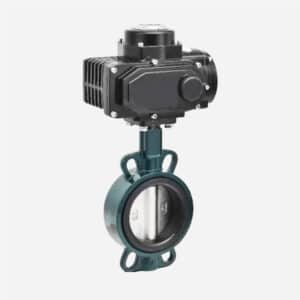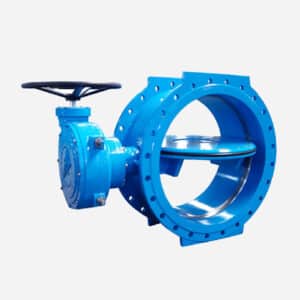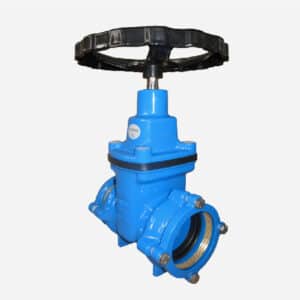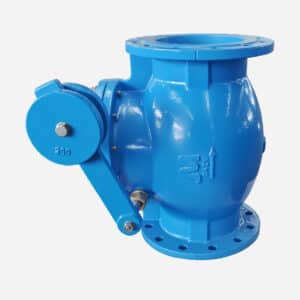Lug Type Butterfly Valve Manufacturer
Lug type butterfly valve is a type of valve that is designed to control the flow of fluids in pipelines. It has flanges with lugs (ears that stick out with bolt holes) on both ends so that it can be bolted directly to the flanges of the pipeline. This design makes a secure and stable connection that makes it easy to install, remove, or replace the valve without disturbing the entire pipeline.
The lug type design is especially useful in applications where you need to control flow in both directions and when you need to do maintenance or isolate the valve without shutting down the entire system.
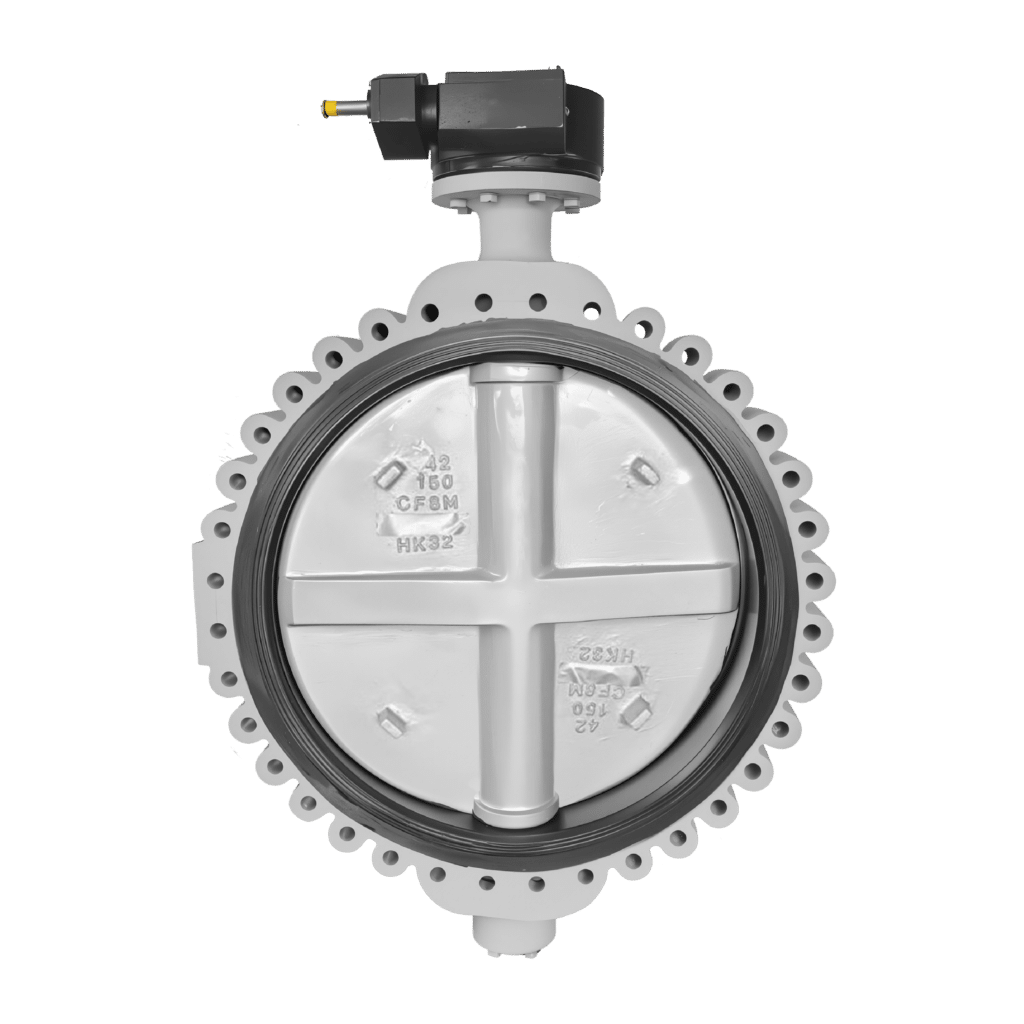
WORKING PRINCIPLE
The basic working principle of a Lug Type Butterfly Valve involves a circular disc (butterfly) that rotates around a central axis. The disc is mounted on a shaft and is controlled by a lever or actuator.
When the valve is open, the disc is positioned parallel to the pipe, allowing fluid to flow with minimal resistance. When the valve is closed, the disc rotates 90 degrees to a perpendicular position, blocking the flow of fluid.
DOUBLE-DIRECTIONAL FLOW CONTROL
_
The lug-type valve design allows the valve to handle fluid flow from either direction without affecting its operation, which makes it more versatile compared to other valve types.
EASY INSTALLATION AND MAINTENANCE
_
The valve can be bolted directly to the pipe’s flanges, making it easier to install, maintain, or replace without affecting the rest of the piping system.
DRAWING
Judberd have two types lug butterfly valve, one is with pin for stem, another one is without pin for stem, The pin design is generally better for applications that require frequent maintenance or part replacements, while the pinless design is preferred for systems where long-term stability is more important.
The pinless design is easier to install and maintain, making it suitable for environments where maintenance is less frequent.
SHAFT WITH PIN CONNECTION
_
● Connection Method
The valve shaft is connected to the valve disc with a pin. This design ensures a stronger and more secure connection between the shaft and the disc, preventing issues like gaps or instability caused by imprecise fit.
● Advantages
The pin connection offers higher stability and reliability, making it suitable for environments with higher torque requirements or more demanding operational conditions. The pin also helps reduce friction between the shaft and the disc, lowering wear and tear.
● Applications
This design is commonly used in systems where precise operation is critical, and the valve is frequently opened and closed, such as in high-pressure or high-flow pipeline systems.
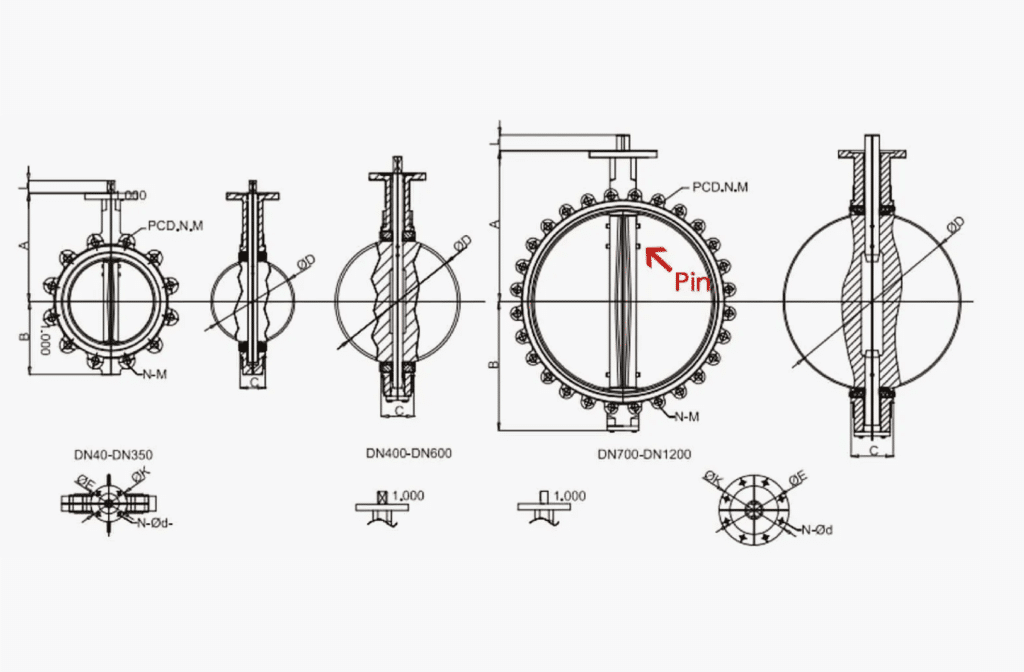
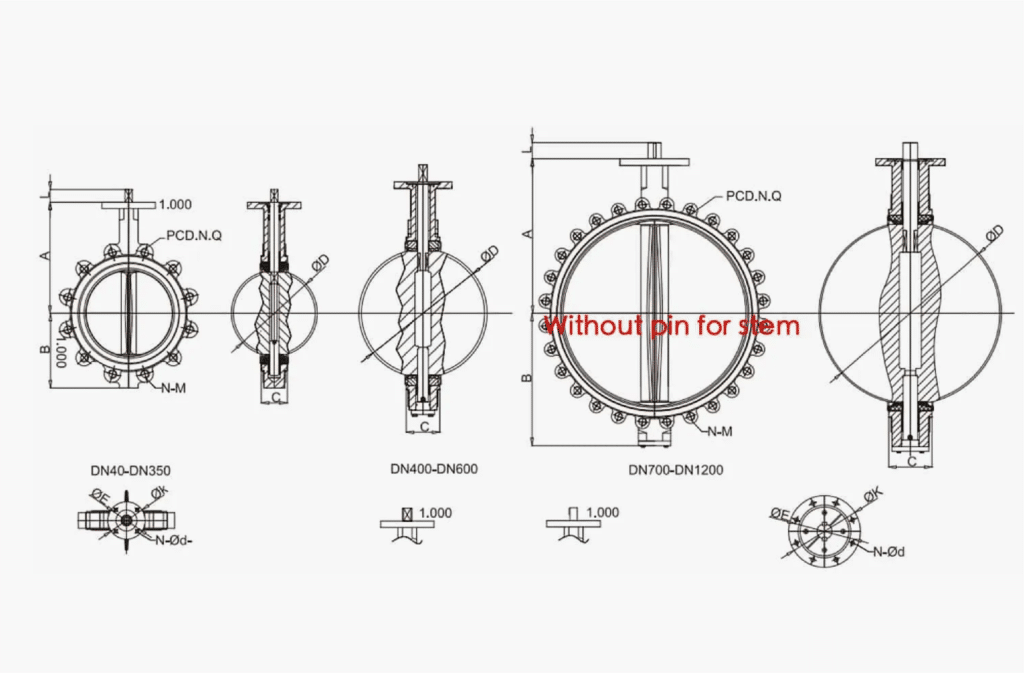
SHAFT WITHOUT PIN (FIT CONNECTION)
_
● Connection Method
The valve shaft and valve disc are connected through a precise dimensional fit, typically through an internal-external diameter fit or an insertion-style connection, without the need for additional pins.
● Advantages
The design is simpler and more cost-effective, as it requires fewer components. The fit between the shaft and disc provides adequate functionality for lower-pressure or lower-temperature environments.
● Applications
This design is typically used in systems where the demands for stability and durability are not as high, such as simpler fluid control systems with less frequent operation.
KEY DIFFERENCES
Stability and Durability
_
The pin-connected design generally performs better in high-load, high-frequency applications, providing greater stability and longevity. In contrast, the fit connection design is simpler and more suitable for less demanding applications.
Cost
_
The pin connection design is more complex and therefore more expensive, while the fit connection design is more economical.
Suitability
_
If the system operates under high pressure, frequent cycling, or requires higher reliability, the pin-connected design is likely the better choice. For more standard applications with lower requirements for precision and durability, the fit connection design provides a cost-effective solution.
The choice between these two designs depends on the specific needs of the pipeline system, the budget, and the required performance standards.
LUG VS WAFER BUTTERFLY VALVE
LUG TYPE BUTTERFLY VALVE
_
ADVANTAGES
● Easier Installation in Multiple Situations
The lug type valve has threaded holes in the body, which allow it to be bolted directly to the flanges on both sides of the pipeline. This gives more flexibility during installation and maintenance because it can be installed between two flanges without needing additional external support.
● Can Be Removed Without Disrupting the System
In cases of maintenance or replacement, a lug-type valve can be removed and replaced without needing to disassemble the entire pipeline system. The flange connections hold the valve in place, so there’s no need to remove or disrupt the adjoining pipeline.
● Higher Mechanical Strength
Because of the threaded lugs, this valve type generally provides better mechanical strength, making it more suitable for high-pressure or larger-diameter applications.
● More Versatility
It can be used for both end-of-line and mid-line applications, offering more versatility in installation locations.
DISADVANTAGES
● Higher Cost
Due to the additional components (e.g., threaded holes), lug type valves tend to be more expensive than wafer type valves.
● Bulkier
Lug type valves may be slightly bulkier compared to wafer type valves, which can be a consideration in space-constrained installations.
● Heavier
Generally heavier than wafer type valves, which can affect the ease of handling and installation, especially for larger valves.
ADVANTAGES
● Compact and Lightweight
Wafer type valves are typically more compact and lighter than lug type valves, making them easier to handle and install, particularly in smaller spaces.
● Lower Cost
Wafer type valves are usually more cost-effective because they lack the extra lugs and threaded holes, making them simpler to manufacture.
● Space-Efficient
The wafer design makes it suitable for installations where space is limited or where the pipeline may need to be more streamlined.
● Easy to Install Between Flanges
These valves are mounted between flanges and are bolted directly into the pipeline, saving space and cost. However, they do require flanges on both sides of the valve for proper installation.
DISADVANTAGES
● Limited to Mid-Line Installations
Wafer valves cannot be installed at the end of the pipeline (end-of-line applications) without additional support. They require flanges on both sides to be installed securely, which limits their versatility in certain configurations.
● Not as Strong in High-Pressure Applications
Due to the lack of threaded lugs, wafer type valves may be less robust in high-pressure or large-diameter applications. The installation relies on the bolted flange connections to hold the valve in place, which may not provide the same mechanical strength as lug type valves.
● Difficult to Remove Without Disrupting the System
If maintenance or replacement is needed, wafer valves typically require the entire pipeline to be shut down or disassembled because they do not have the same ability to be removed without disturbing the adjoining pipe.
KEY DIFFERENCES
FLEXIBILITY IN INSTALLATION
_
Lug type valves offer more flexibility, allowing installation at both ends of the pipeline or mid-line, and can be removed without disturbing the system. Wafer valves require flanges on both sides and are generally not suitable for end-of-line applications.
COST AND WEIGHT
_
Wafer valves are generally cheaper and lighter, making them more suitable for cost-sensitive projects or installations where space and weight are concerns.
STRENGTH AND DURABILITY
_
Lug type valves generally offer better mechanical strength and are more durable, making them ideal for high-pressure, large-diameter systems, whereas wafer type valves are better for smaller, less demanding applications.
● Lug type butterfly valves are more versatile, durable, and suitable for high-pressure systems, but they come at a higher cost and may be bulkier.
● Wafer type butterfly valves are simpler, lighter, and more cost-effective, ideal for smaller, mid-line installations, but are less suitable for high-pressure environments or end-of-line applications.
● The choice between the two largely depends on the specific application, budget, and the environment in which the valve will be used.
LUG TYPE BUTTERFLY VALVE DIFFERENT MATERIAL AND THEIR APPLICATION
When selecting materials for lug type butterfly valves, the choice of material depends on the specific application,
the medium being transported, the operating temperature, pressure, and environmental factors.
Here are some common materials used for lug type butterfly valves and their suitable applications:
1. CAST IRON (DUCTILE OR GRAY CAST IRON)
ADVANTAGES
● Cost-Effective
Cast iron is one of the most affordable materials for butterfly valves.
● Good Strength
It offers good strength and durability for lower pressure applications.
SUITABLE APPLICATIONS
● Water Systems
Cast iron valves are commonly used in water treatment plants, municipal water pipelines, and sewage systems.
● Low to Medium Pressure
Ideal for lower pressure applications (up to 150 psi).
● Non-Corrosive or Mildly Corrosive Fluids
Suitable for water, wastewater, or slurries that are not highly corrosive.
LIMITATIONS
● Corrosion Resistance
Cast iron can be prone to corrosion in aggressive environments, such as those with seawater or acidic liquids. It may need additional coatings (such as epoxy or fusion bonded epoxy) to improve corrosion resistance.
2. STAINLESS STEEL (SS304, SS316, SS316L)
EXCELLENT CORROSION RESISTANCE
● Cost-Effective
Stainless steel is highly resistant to corrosion, especially SS316 and SS316L, making them ideal for harsh environments.
● High Strength
Stainless steel offers excellent mechanical properties, making it suitable for high-pressure and high-temperature applications.
SUITABLE APPLICATIONS
● Chemical, Food & Beverage, Pharmaceutical Industries
SS316 and SS316L are commonly used in chemical processing, food production, and pharmaceutical applications due to their excellent corrosion resistance, especially in environments with acids, alkalis, and organic solvents.
● Marine Environments
SS316 is highly resistant to corrosion caused by saltwater, making it ideal for coastal or marine applications.
● High-Temperature Applications
Stainless steel valves perform well under high-temperature conditions, making them suitable for steam systems or systems with high fluid temperatures.
● Oil & Gas Pipelines
Stainless steel, especially SS316, is often used in oil and gas pipeline systems due to its durability and corrosion resistance.
LIMITATIONS
● Cost
Stainless steel is more expensive than materials like cast iron or carbon steel.
● Weight
Stainless steel valves are typically heavier than other materials.
3. ALUMINUM (ALUMINUM ALLOY)
ADVANTAGES
● Lightweight
Aluminum is significantly lighter than other materials like cast iron or stainless steel, making it easier to handle and install.
● Corrosion Resistant
Aluminum offers good resistance to corrosion, especially in environments where there’s exposure to moisture or mild corrosive substances.
● Good for Low to Medium Pressure
Aluminum is often used in less demanding applications due to its relatively lower strength compared to stainless steel.
SUITABLE APPLICATIONS
● Low-Pressure Systems
Aluminum butterfly valves are ideal for low-pressure applications, such as HVAC systems, air, and water distribution systems.
● Non-Corrosive or Mildly Corrosive Fluids
Aluminum works well in environments where the medium is non-corrosive or only mildly corrosive, such as clean water or air systems.
LIMITATIONS
● Not Suitable for High-Pressure or High-Temperature Applications
Aluminum may not perform well under extreme pressures or temperatures.
● Less Durable than Steel
Aluminum is less durable than stainless steel or cast iron, especially in heavy-duty applications.
4. CARBON STEEL
EXCELLENT CORROSION RESISTANCE
● Strong and Durable
Carbon steel offers excellent strength and is suitable for applications with higher pressure and temperature.
● Cost-Effective
It is less expensive than stainless steel while providing good mechanical properties.
SUITABLE APPLICATIONS
● Water and Gas Distribution
Carbon steel valves are commonly used in water, natural gas, and other pipeline systems that don’t require the extreme corrosion resistance of stainless steel.
● Chemical Processing
Carbon steel valves can be used in certain chemical environments, though they may need additional coatings (e.g., epoxy, galvanizing) to enhance corrosion resistance.
● Oil and Gas
Carbon steel is often used in oil and gas pipelines where strength is more important than corrosion resistance.
LIMITATIONS
● Corrosion Risk
Carbon steel is susceptible to corrosion, especially in water or acidic environments, unless it is coated or lined with a corrosion-resistant material.
● Requires Maintenance
Carbon steel valves may require more frequent maintenance and inspection to ensure their longevity, especially in outdoor or humid environments.
5. BRONZE AND BRASS
ADVANTAGES
● Corrosion Resistance
Bronze and brass are resistant to corrosion, particularly in water and marine environments.
● Good for Low Pressure
These materials are suitable for low-pressure applications and are often used in smaller valve sizes.
SUITABLE APPLICATIONS
● Marine and Seawater Systems
Bronze and brass are often used in marine applications where the valve may be exposed to seawater.
● Heating, Ventilation, and Air Conditioning (HVAC)
They are also suitable for HVAC systems due to their corrosion resistance.
● Non-Corrosive Fluids
These materials work well with fresh water or mild chemical solutions.
LIMITATIONS
● Lower Strength than Steel
Bronze and brass have lower strength compared to materials like stainless steel or carbon steel, so they are not suitable for high-pressure applications.
● Expensive
These materials tend to be more expensive than cast iron or aluminum.
6. PVC, CPVC, AND OTHER PLASTIC MATERIALS
EXCELLENT CORROSION RESISTANCE
● Lightweight
Plastic materials are very lightweight, making them easy to handle and install.
● Corrosion Resistant
They are highly resistant to a wide range of chemicals and offer excellent performance in corrosive environments.
● Cost-Effective
Plastic materials are often cheaper than metal options.
SUITABLE APPLICATIONS
● Chemical and Wastewater Systems
PVC and CPVC valves are widely used in chemical processing and wastewater systems where resistance to corrosion and chemicals is crucial.
● Non-Pressurized Systems
These valves are typically used in low-pressure applications.
LIMITATIONS
● Limited to Low-Pressure and Temperature
Plastic valves cannot handle high-pressure or high-temperature applications as effectively as metal valves.
● Brittle in Certain Conditions
Some plastic materials can become brittle over time or under extreme temperatures.
MATERIAL SELECTION CRITERIA
When choosing the appropriate material for a lug type butterfly valve, consider the following factors:
PIPELINE MEDIUM
_
Is the fluid corrosive, abrasive, or prone to cause scaling? For aggressive chemicals, stainless steel or special coatings may be needed. For clean water, cast iron might be sufficient.
PRESSURE AND TEMPERATURE
_
High-pressure systems require stronger materials like stainless steel or carbon steel, while lower pressure systems can use materials like aluminum or cast iron.
CORROSION RESISTANCE
_
If the valve will be exposed to seawater, acids, or other corrosive substances, stainless steel (SS316, SS316L) or bronze may be required.
COST CONSIDERATIONS
_
If cost is a critical factor, materials like cast iron or aluminum may be more appropriate, as they are more affordable than stainless steel.
WEIGHT CONSTRAINTS
_
If installation requires lightweight valves, aluminum or plastic materials may be better.
CONCLUSION
CAST IRON
Cost-effective, used in water and sewage systems.
STAINLESS STEEL (SS304/SS316)
Corrosion-resistant, suitable for chemical, marine, and high-pressure systems.
ALUMINUM
Lightweight, ideal for low-pressure, non-corrosive applications.
CARBON STEEL
Strong and durable, but requires coatings for corrosion resistance.
BRONZE/BRASS
Corrosion-resistant, good for low-pressure and marine applications.
PLASTIC (PVC/CPVC)
Chemical-resistant, best for low-pressure systems.
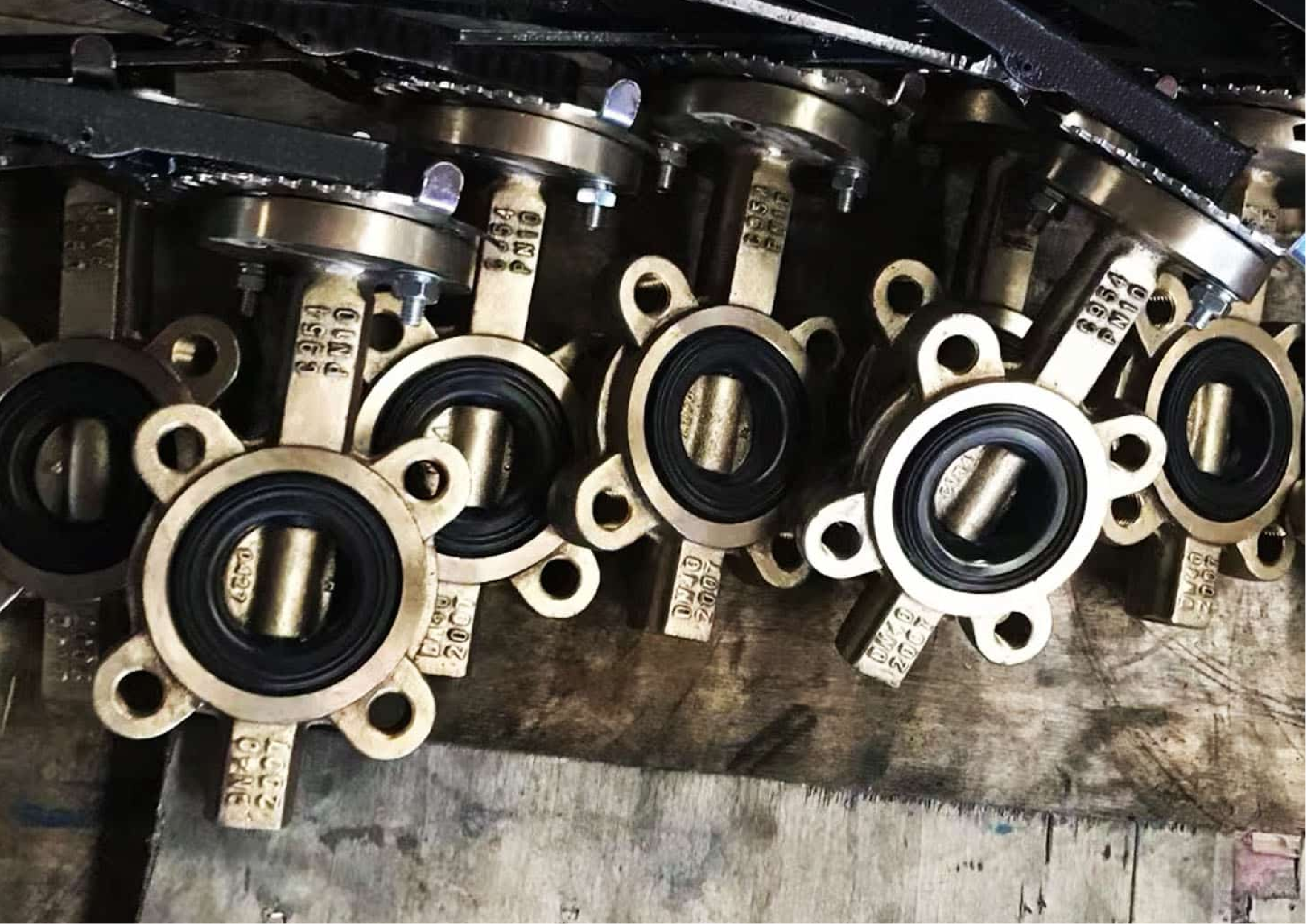
BRASS/BRONZE LUG TYPE BUTTERFLY VALVE
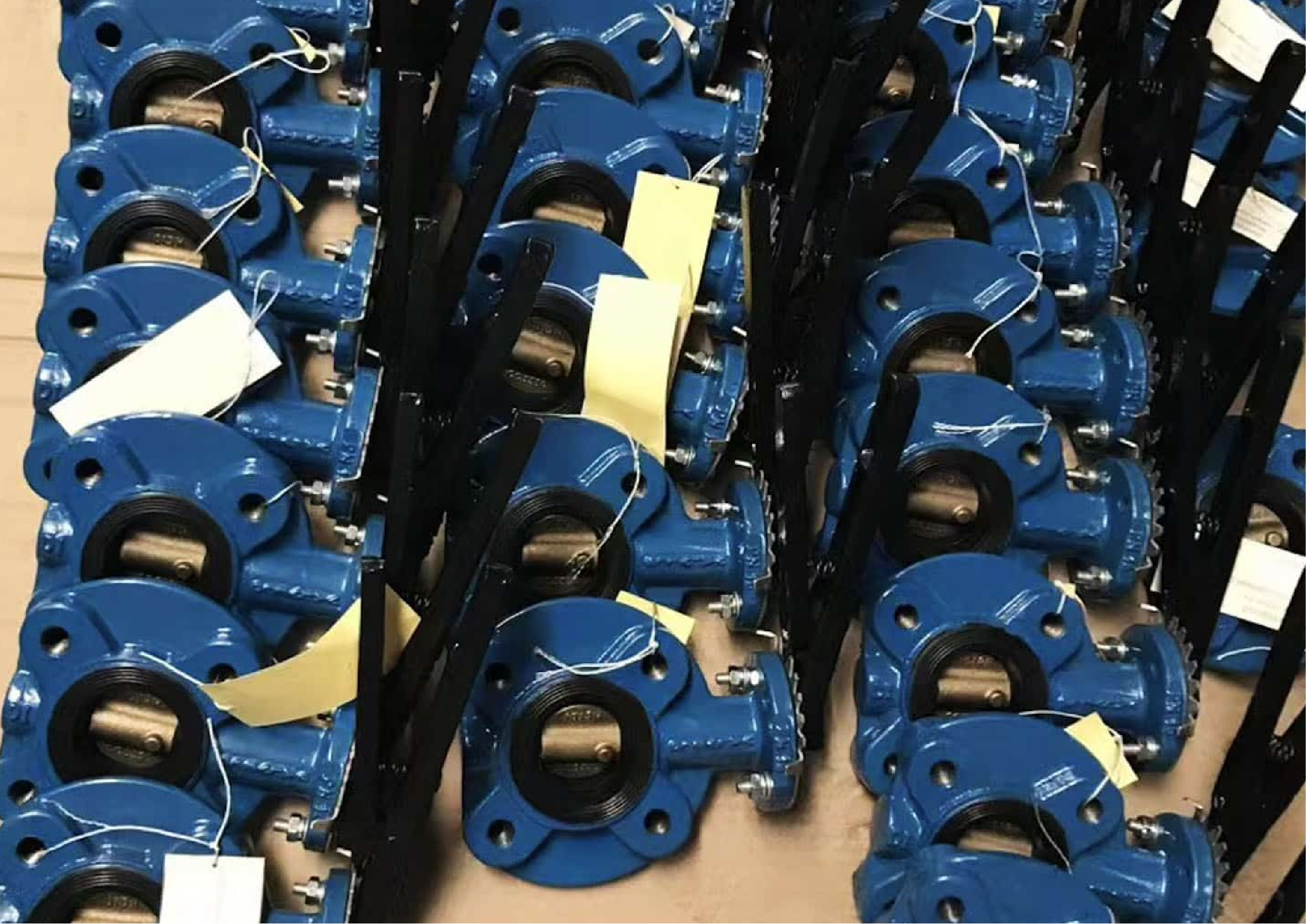
DUCTILE IRON LUG TYPE BUTTERFLY VALVE
HOW TO CHOOSE RIGHT LUG TYPE BUTTERFLY VALVE?
1. DRINKING WATER SYSTEMS
● Material Choice
For drinking water systems, the valve material must comply with health and safety standards to prevent any harmful substances from leaching. Common materials are cast iron (coated) or stainless steel (SS304, SS316), which are corrosion-resistant and safe for potable water.
● Seal Material
The gasket material is typically EPDM (Ethylene Propylene Diene Monomer), as it offers excellent sealing performance with water and is resistant to water quality changes.
● Durability and Pressure Rating
The working pressure for drinking water systems is typically moderate, so a PN10-PN16 pressure rating should suffice, suitable for regular flow.
● Installation Requirements
Drinking water systems often require easy dismantling for periodic checks and maintenance. The Lug-type butterfly valve design is ideal as it allows for quick removal without disrupting the system.
2. Seawater Systems
● Material Choice
Seawater is highly corrosive, so it’s recommended to choose stainless steel (SS316 or higher grades) for better corrosion resistance. The valve’s exterior can be coated with FBE (Fusion Bonded Epoxy) or epoxy resin coatings to enhance seawater corrosion resistance.
● Seal Material
EPDM or Viton gaskets are ideal for seawater systems. Viton is especially suitable for high temperatures and more aggressive seawater environments.
● Temperature and Pressure
The working pressure and temperature for seawater systems are typically moderate, but due to the abrasive nature of seawater, it’s good to choose valves with wear-resistant liners like PTFE or rubber linings for added protection.
● Sealing and Corrosion Resistance
Given seawater’s high corrosive nature, a focus on seal performance and long-lasting corrosion resistance is essential.
3. SEWAGE SYSTEMS
● Material Choice
Sewage systems require valves that can handle contaminants and corrosive waste. Cast iron or carbon steel (coated) valves are common, with an epoxy resin coating on the exterior for extra protection.
● Seal Material
NBR (Nitrile Rubber) or EPDM seals are preferred, as they can effectively resist the chemicals and pollutants found in wastewater.
● Durability and Pressure Rating
Sewage systems usually operate at moderate pressures, so PN10 or PN16 valves are typical. If higher flow or pressure is expected, consider valves with a higher pressure rating.
● Installation Requirements
Given the potential for solids or sediment, choosing valves with strong wear resistance and easy cleanability is key for reliable performance.
4. OIL PIPELINE SYSTEMS
● Material Choice
For oil pipelines, the valve material should be carbon steel or stainless steel (SS316), depending on the type of oil and its corrosiveness.
● Seal Material
NBR (Nitrile Rubber) is ideal for oil pipelines as it provides excellent sealing and resistance to petroleum products.
● Pressure and Temperature
Oil pipelines often require valves rated for high pressure and temperature. Choose valves with PN25 or PN40 ratings to handle higher pressures and temperatures safely.
● Explosion-Proof Requirements
In some cases, the valve may need to meet fire-resistant or explosion-proof standards, so ensure the valve complies with relevant industry safety standards.
5. GAS PIPELINE SYSTEMS
● Material Choice
Gas pipelines require valves made of cast iron or stainless steel (SS304 or SS316) to ensure strength and corrosion resistance.
● Seal Material
NBR or Viton seals are suitable, especially Viton, which provides excellent sealing in gas systems.
● Pressure Rating
Gas pipelines typically operate under high pressure, so a PN25 or higher pressure rating is necessary
● Safety Requirements
Gas systems demand highly reliable sealing to prevent leaks. Choose valves with enhanced sealing capabilities to meet stringent safety standards.
6. CORROSIVE MEDIA PIPELINES
● Material Choice
For pipelines carrying highly corrosive media (such as strong acids, alkalis, or corrosive gases), select SS316, corrosion-resistant alloys, or valves with PTFE linings for the best protection against chemical attack.
● Seal Material
PTFE or Viton seals are essential for handling aggressive media, as these materials offer excellent resistance to chemicals.
● Temperature and Pressure
For high-temperature or high-pressure applications, make sure the valve is designed to withstand extreme conditions. Choose valves with high-temperature ratings and corrosion-resistant materials.
● Sealing and Durability
Ensure the valve has robust sealing properties and is durable enough to handle the aggressive nature of the fluid while maintaining long-term performance.
7. HIGH-PRESSURE PIPELINES
● Material Choice
High-pressure pipelines demand valves that can withstand significant force. Carbon steel or stainless steel (SS316) are the materials of choice, designed to handle the high stress in the pipeline.
● Seal Material
NBR or Viton seals are commonly used to ensure proper sealing under high pressure, offering good resistance to wear and high pressure.
● Pressure Rating
For high-pressure pipelines, you’ll need a PN40 or even PN63 rated valve to withstand the extreme pressure levels.
● Design and Safety
High-pressure systems require valves with reinforced construction and precise sealing to ensure safety and prevent any leaks under pressure.
When selecting a Lug Type Butterfly Valve, it’s crucial to consider the specific conditions of the pipeline system, including the type of medium, temperature, pressure, and corrosiveness. Key factors to focus on are the material selection (for both the valve body and seals), pressure and temperature ratings, and any additional requirements such as corrosion resistance or wear protection. By matching the valve’s specifications with the system’s needs, you can choose the most appropriate valve for your application.
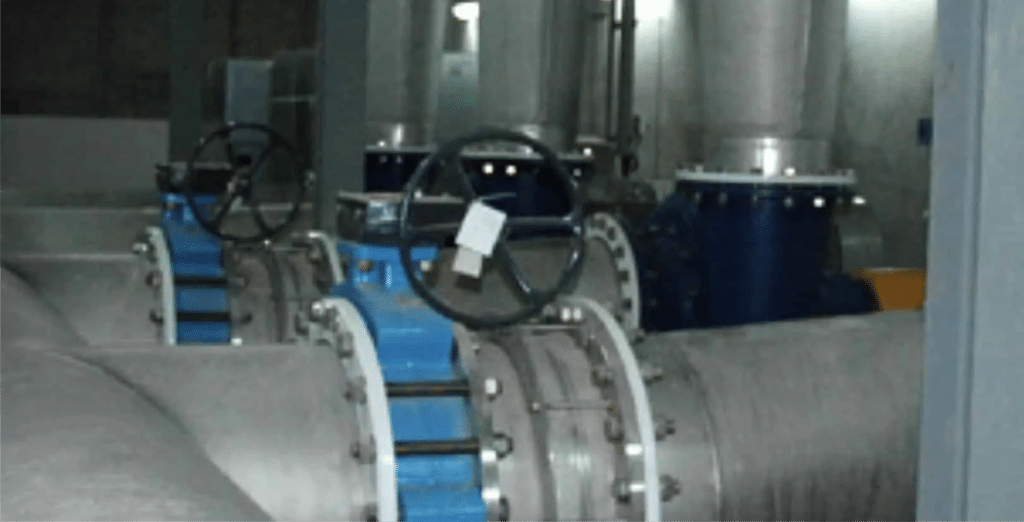
INSTALLATION AND MAINTENANCE
The installation and maintenance of a Lug Type Butterfly Valve are crucial to ensuring its performance, reliability, and longevity.
Here’s a detailed breakdown of the installation method and maintenance requirements:
INSTALLATION OF LUG TYPE BUTTERFLY VALVE
PREPARATION BEFORE INSTALLATION
_
● Connection Method
Before installation, verify that the valve’s size and pressure rating match the specifications of the pipeline. Double-check the flange dimensions (according to ANSI, DIN, or other standards), and ensure that the valve is the right fit for the pipeline.
● Clean the Pipe Ends
Ensure the pipe ends are clean, free from debris, and free from any foreign materials that could affect sealing. The pipe should be deburred to avoid damaging the valve seals during installation.
● Check Valve Condition
Inspect the valve for any damage that might have occurred during transportation. Ensure the valve is clean and free from any rust, dirt, or particles that could affect its functionality.
POSITIONING THE VALVE
_
● Lug Type Design
Lug type butterfly valves are designed with threaded lugs on both sides of the valve body. These lugs allow the valve to be bolted directly to the pipeline without the need for additional support or flanged connections.
● Positioning
Install the valve between two flanges, making sure that the direction of flow aligns with the valve’s designated flow direction (check the valve’s flow direction arrow). The valve should be positioned such that the disc is fully closed before securing bolts.
BOLTING
_
● Connection Method
Tighten the bolts in a star pattern or opposite diagonal pattern to ensure even pressure distribution across the valve flange. This helps achieve a proper seal.
● Clean the Pipe Ends
Always follow the manufacturer’s recommended torque settings for bolting the valve to the pipe. Over-tightening can damage the valve, while under-tightening may lead to leaks.
● Check Valve Condition
Ensure the valve’s body is properly aligned with the pipeline. Misalignment could result in uneven loading on the valve and cause premature wear or failure.
Make sure the actuator (if used) is properly aligned with the valve stem and the pipeline, ensuring smooth operation.
POST-INSTALLATION CHECK
_
● Check for Leaks
After installation, perform a pressure test to check for any leaks around the flange and valve body. Ensure there are no signs of leakage.
● Operation Check
Operate the valve manually or with an actuator to verify that the valve opens and closes smoothly. Ensure there’s no resistance or binding during operation.
MAINTENANCE OF LUG TYPE BUTTERFLY VALVE
REGULAR INSPECTIONS
_
● Visual Inspection
Regularly inspect the valve for any signs of external damage, wear, or corrosion, especially on the actuator (if installed), flanges, seals, and bolts. Any visible damage should be addressed promptly to avoid operational issues.
● Leakage Check
Periodically check for leaks around the valve body, flange connections, and shaft seals. Leaking can often indicate that the seals are deteriorating and need replacing.
SEAL MAINTENANCE
_
● Inspect Seals Regularly
Gaskets or seals (such as EPDM, Viton, NBR, etc.) may wear over time due to exposure to the pipeline medium. They should be inspected regularly for signs of cracking, degradation, or damage.
● Replace Worn Seals
If seals are found to be damaged or ineffective, they should be replaced immediately. This is important to maintain a proper seal and avoid leakage.
LUBRICATION
_
● Lubricate Moving Parts
Lubricate the valve stem and actuator components (if applicable) to prevent excessive wear and corrosion. Use the manufacturer-recommended lubricant, and ensure it’s compatible with the pipeline medium to avoid contamination.
● Lubricate Bearings and Shaft
If the valve has bearings or moving parts, they should be regularly lubricated to ensure smooth operation and to prevent premature wear.
CLEANING
_
● External Cleaning
Clean the valve body and actuator (if installed) to remove dirt, corrosion, and any buildup that could affect performance. Use a non-abrasive cloth and appropriate cleaning agents.
● Internal Cleaning
Depending on the medium being transported, internal cleaning may be required to remove debris, sediment, or buildup. If the valve is in a system with particulate flow, regular maintenance may be needed to prevent clogging or damage.
ACTUATOR MAINTENANCE
_
● Check Actuator Function
If an actuator (manual, pneumatic, or electric) is installed, check its function regularly. Ensure it is operating correctly, opening and closing the valve without issues. Perform a visual inspection of the actuator components and check for any leaks in pneumatic or hydraulic systems.
● Calibrate the Actuator
For electric actuators, calibrate the actuator to ensure it is functioning properly and opening/closing the valve within the specified range.
CORROSION PROTECTION
_
● Check for Corrosion
Depending on the medium, corrosion can develop on the valve over time. Regularly check the valve body and flange areas for corrosion, especially in systems like seawater or chemicals.
● Reapply Coatings
If the valve has any protective coatings (such as epoxy or FBE coatings), inspect the coatings regularly. If the coatings show signs of degradation, they should be reapplied to protect the valve from further corrosion.
PRESSURE TESTING
_
● Periodic Pressure Testing
For safety, conduct pressure tests periodically to ensure that the valve and its seals are functioning correctly. This should be done according to the pipeline system’s maintenance schedule.
● Test for Full Functionality
Operate the valve under different pressure conditions to ensure it can perform correctly under operating conditions.
Proper installation and maintenance of a Lug Type Butterfly Valve are essential for ensuring its performance and longevity. Follow manufacturer guidelines for installation, ensure proper bolting and alignment, and regularly inspect the valve, seals, and actuator. Periodic maintenance such as lubrication, cleaning, and seal replacement will help keep the valve in good working condition and prevent costly repairs or downtime.

